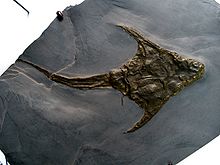Lunaspis
|
Lunaspis Temporal range: Emsian |
|
|---|---|
 |
|
| Fossil of L. broili | |
| Scientific classification | |
| Kingdom: | Animalia |
| Phylum: | Chordata |
| Class: | Placodermi |
| Order: | Petalichthyida |
| Family: | Macropetalichthyidae |
| Genus: | Lunaspis |
| Species: | L. heroldi |
| Type species | |
|
Lunaspis heroldi Broili 1929 |
|
| species | |
|
|
| Synonyms | |
|
|
Lunaspis is an extinct genus of armor-plated petalichthyid placoderm fish that lived in shallow marine environments of the Early Devonian period, from approximately 409.1 to 402.5 million year ago. Fossils have been found in Germany, China and Australia. There are three different identified species of within the genus Lunaspis:L. broilii, L. heroldi, and L. prumiensis.
Like many other petalichthyid fish, Lunaspis are flat and have elongated pectoral spines, shortened thoracic armor, and dorsally oriented eyes.Lunaspis has been studied mainly by German, Australian, and Chinese palaeontologists because of where it is most commonly encountered. The tails are long and thin and resemble a whip, somewhat like extant skates and rays.
A typical individual of Lunaspis was a flattened fish with a short trunk and long, curved cornual plates. These long, spine-like plates give the suggestion of a crescent moon, hence the generic name (moon-shield). The nostrils and the anterior part of the head shield around the orbits is covered by a number of tiny scales, as is the elongated trunk.
Lunaspis were marine bottom dwelling creatures, like many other Devonian placoderm fish, and were nektonic carnivores. The body shape of Lunaspis is also similar to other petalichthyid fish, compressed dorsoventrally. Its body consists of a short trunk shield and elongated cronual plates (the wing-like structures that make up the crescent shape of the moon-like head). The rest of the body, which excludes those parts covered in the enlarged plates of armor, are covered in tiny scales, as is the anterior region of the face near the orbits and nostrils.Lunaspis also has two traits that are thought to be primitive, or ancestral: large submarginal plates and the occurrence of a ventral pit on the median dorsal plate.
According to specimens examined from the Taemas-Wee Jasper region of New South Wales in Australia, both L. broilii and L. herolfi have tubercles of the median dorsal plate coalesce into a distinct median dorsal ridge (MDR). The fusion of the tubercles is unique to Lunaspis in the order Petalichthyida, where other devonian fish in this order have ornament tubercles that are separately occurring. The maximum height of the ridge is reached before the posterior margin of the median dorsal plate. The spinal plates are curved and are the wings off of the center part of the bony armoring. They have many small spines along the anterior ridge of spinal plates. The ornament ridges on the bony plates make it easily distinguishable from other petalichtyid fish. These ornament ridges are widely spaced and continuous in the Lunaspis, across the three species; in L. broilii, the ornaments are more densely packed than L. heroldi and L. prumiensis.
...
Wikipedia
